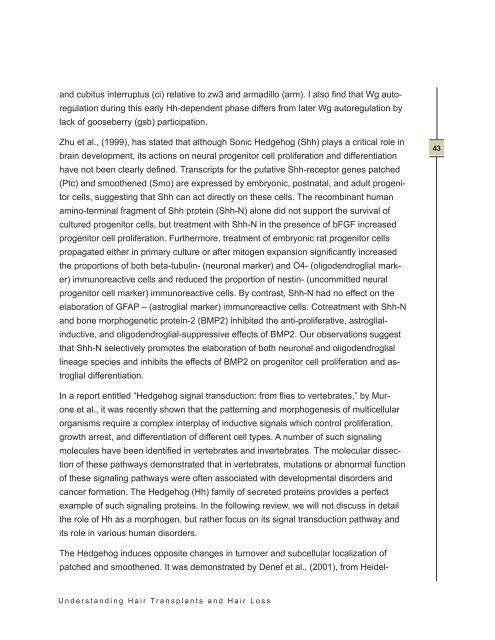Understanding Hair Transplants and Hair Loss - Pacific Hair
Understanding Hair Transplants and Hair Loss - Pacific Hair
Understanding Hair Transplants and Hair Loss - Pacific Hair
You also want an ePaper? Increase the reach of your titles
YUMPU automatically turns print PDFs into web optimized ePapers that Google loves.
<strong>and</strong> cubitus interruptus (ci) relative to zw3 <strong>and</strong> armadillo (arm). I also find that Wg auto-<br />
regulation during this early Hh-dependent phase differs from later Wg autoregulation by<br />
lack of gooseberry (gsb) participation .<br />
Zhu et al ., (1999), has stated that although Sonic Hedgehog (Shh) plays a critical role in<br />
brain development, its actions on neural progenitor cell proliferation <strong>and</strong> differentiation<br />
have not been clearly defined. Transcripts for the putative Shh-receptor genes patched<br />
(Ptc) <strong>and</strong> smoothened (Smo) are expressed by embryonic, postnatal, <strong>and</strong> adult progenitor<br />
cells, suggesting that Shh can act directly on these cells . The recombinant human<br />
amino-terminal fragment of Shh protein (Shh-N) alone did not support the survival of<br />
cultured progenitor cells, but treatment with Shh-N in the presence of bFGF increased<br />
progenitor cell proliferation . Furthermore, treatment of embryonic rat progenitor cells<br />
propagated either in primary culture or after mitogen expansion significantly increased<br />
the proportions of both beta-tubulin- (neuronal marker) <strong>and</strong> O4- (oligodendroglial marker)<br />
immunoreactive cells <strong>and</strong> reduced the proportion of nestin- (uncommitted neural<br />
progenitor cell marker) immunoreactive cells . By contrast, Shh-N had no effect on the<br />
elaboration of GFAP – (astroglial marker) immunoreactive cells . Cotreatment with Shh-N<br />
<strong>and</strong> bone morphogenetic protein-2 (BMP2) inhibited the anti-proliferative, astroglialinductive,<br />
<strong>and</strong> oligodendroglial-suppressive effects of BMP2 . Our observations suggest<br />
that Shh-N selectively promotes the elaboration of both neuronal <strong>and</strong> oligodendroglial<br />
lineage species <strong>and</strong> inhibits the effects of BMP2 on progenitor cell proliferation <strong>and</strong> astroglial<br />
differentiation .<br />
In a report entitled “Hedgehog signal transduction: from flies to vertebrates,” by Murone<br />
et al ., it was recently shown that the patterning <strong>and</strong> morphogenesis of multicellular<br />
organisms require a complex interplay of inductive signals which control proliferation,<br />
growth arrest, <strong>and</strong> differentiation of different cell types . A number of such signaling<br />
molecules have been identified in vertebrates <strong>and</strong> invertebrates. The molecular dissection<br />
of these pathways demonstrated that in vertebrates, mutations or abnormal function<br />
of these signaling pathways were often associated with developmental disorders <strong>and</strong><br />
cancer formation . The Hedgehog (Hh) family of secreted proteins provides a perfect<br />
example of such signaling proteins. In the following review, we will not discuss in detail<br />
the role of Hh as a morphogen, but rather focus on its signal transduction pathway <strong>and</strong><br />
its role in various human disorders .<br />
The Hedgehog induces opposite changes in turnover <strong>and</strong> subcellular localization of<br />
patched <strong>and</strong> smoothened. It was demonstrated by Denef et al., (2001), from Heidel-<br />
U n d e r s t a n d i n g H a i r T r a n s p l a n t s a n d H a i r L o s s<br />
43


